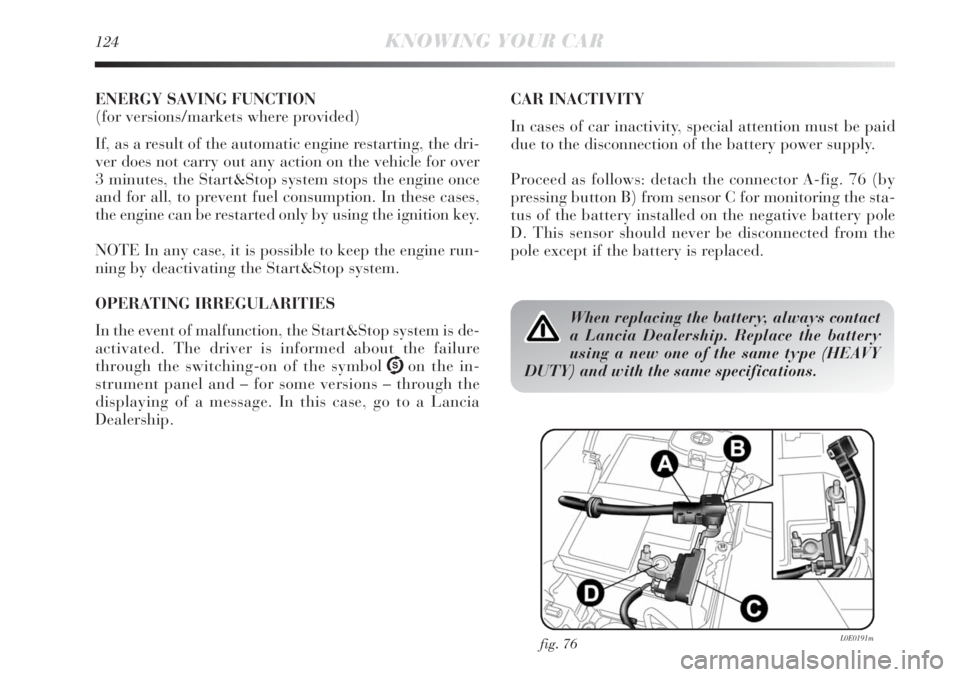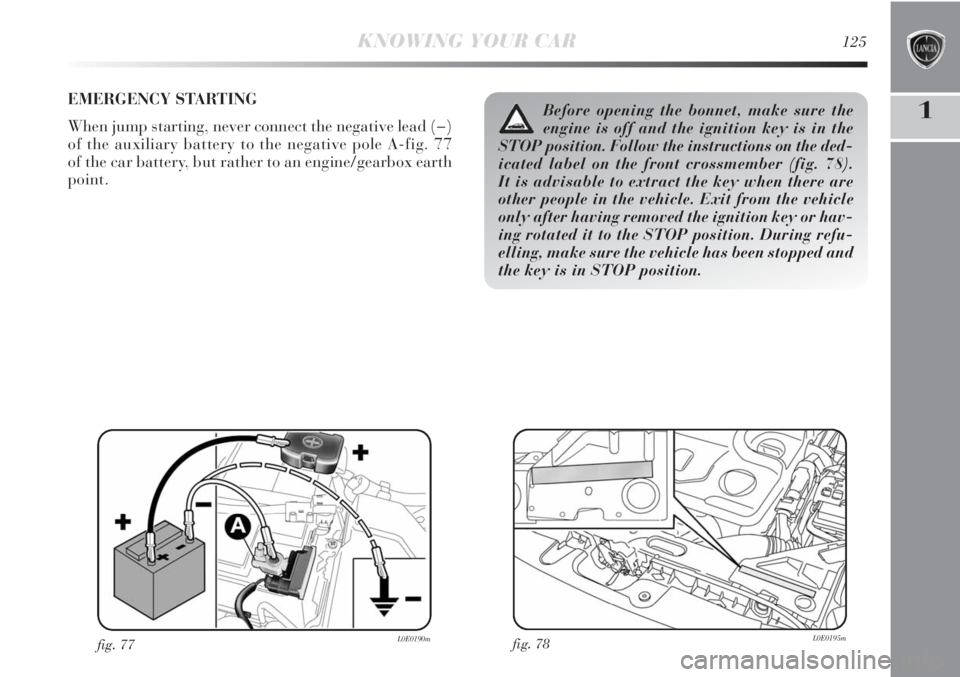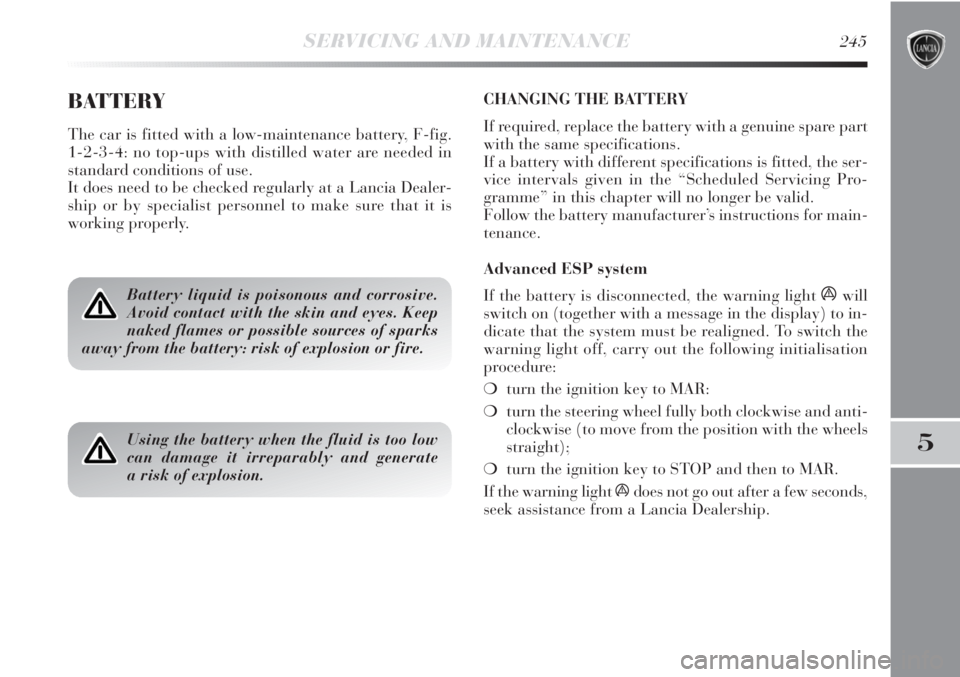key battery Lancia Delta 2012 Owner handbook (in English)
[x] Cancel search | Manufacturer: LANCIA, Model Year: 2012, Model line: Delta, Model: Lancia Delta 2012Pages: 295, PDF Size: 8.29 MB
Page 92 of 295

90KNOWING YOUR CAR
IMPORTANT If the battery is disconnected or the pro-
tection fuse blows, the luggage compartment opening/
closing mechanism must be initialised as follows:
❍shut all the doors;
❍press button
Áon the key or door lock/release but-
ton
≈in the dashboard;
❍press button
Ëon the key or door lock/release but-
ton
≈in the dashboard.
If the child lock was engaged and the previ-
ously described locking procedure carried
out, operating the internal handle will not
open the door but will only realign the door lock
knobs. To open the door, the outside handle must be
used. The door central locking/unlocking button is
not disabled by the engagement of the emergency
lock
≈.
POWER WINDOWS
These operate when the ignition key is turned to MAR and
for about 2 minutes after turning the key to STOP or re-
moving it.
The control buttons are located in the door panels (the
driver side door panel can be used to operate all the
windows).
An anti-pinch device is operated when the front windows
are lifted.
CONTROLS fig. 54
A. opening/closing left hand front window; “continuous
automatic” operation during window opening/closing
stage;
B. opening/closing right hand front window; “continu-
ous automatic” operation during window opening/
closing stage;
C. enabling/disabling of rear door electric window con-
trols;
D. opening/closing left hand rear window (for versions/
markets, where provided); “continuous automatic”
operation during window opening/closing stage;
E.opening/closing right hand rear window (where pro-
vided); “continuous automatic” operation during win-
dow opening/closing stage.
Page 125 of 295

1
KNOWING YOUR CAR123
ENGINE RESTARTING CONDITIONS
For reasons of comfort, limiting harmful emissions and
safety purposes, the power unit can restart automatically
without any action on behalf of the driver if certain con-
ditions are met, including:
❍battery not sufficiently charged;
❍reduced braking system pressure, e.g. following the
brake pedal being pressed repeatedly;
❍car moving (e.g. when driving on roads with a gra-
dient);
❍engine stopping by Start&Stop system for over 3 min-
utes;
❍for versions equipped with dual zone automatic cli-
mate control (for versions/markets where provided),
to enable suitable thermal comfort or MAX-DEF
function activation.
With gear engaged, automatic engine restarting is possi-
ble only by fully pressing the clutch pedal.
The driver is informed by the displaying of a message and
– for versions/markets where provided – by the flashing
of the symbol U.Notes
If the clutch is not pressed, after 3 minutes from the en-
gine stopping, the engine can be restarted only using the
ignition key.
In cases when the engine stops and this is not desired, due
for example to the clutch pedal being released sharply
with a gear engaged, if the Start&Stop system is acti-
vated, the engine can be restarted by fully depressing the
clutch pedal or by placing the gear lever in neutral
SAFETY FUNCTIONS
When the engine is stopped by the Start&Stop system,
if the driver releases his/her seat belt and opens the dri-
ver’s or passenger’s door, the engine can be restarted only
using the ignition key.
The driver is informed by a buzzer and by the flashing
of the symbol Uon the display; on some versions, a mes-
sage is displayed as well.
Page 126 of 295

124KNOWING YOUR CAR
ENERGY SAVING FUNCTION
(for versions/markets where provided)
If, as a result of the automatic engine restarting, the dri-
ver does not carry out any action on the vehicle for over
3 minutes, the Start&Stop system stops the engine once
and for all, to prevent fuel consumption. In these cases,
the engine can be restarted only by using the ignition key.
NOTE In any case, it is possible to keep the engine run-
ning by deactivating the Start&Stop system.
OPERATING IRREGULARITIES
In the event of malfunction, the Start&Stop system is de-
activated. The driver is informed about the failure
through the switching-on of the symbol Uon the in-
strument panel and – for some versions – through the
displaying of a message. In this case, go to a Lancia
Dealership.CAR INACTIVITY
In cases of car inactivity, special attention must be paid
due to the disconnection of the battery power supply.
Proceed as follows: detach the connector A-fig. 76 (by
pressing button B) from sensor C for monitoring the sta-
tus of the battery installed on the negative battery pole
D. This sensor should never be disconnected from the
pole except if the battery is replaced.
fig. 76L0E0191m
When replacing the battery, always contact
a Lancia Dealership. Replace the battery
using a new one of the same type (HEAVY
DUTY) and with the same specifications.
Page 127 of 295

1
KNOWING YOUR CAR125
EMERGENCY STARTING
When jump starting, never connect the negative lead (−)
of the auxiliary battery to the negative pole A-fig. 77
of the car battery, but rather to an engine/gearbox earth
point.
fig. 77L0E0190mfig. 78L0E0195m
Before opening the bonnet, make sure the
engine is off and the ignition key is in the
STOP position. Follow the instructions on the ded-
icated label on the front crossmember (fig. 78).
It is advisable to extract the key when there are
other people in the vehicle. Exit from the vehicle
only after having removed the ignition key or hav-
ing rotated it to the STOP position. During refu-
elling, make sure the vehicle has been stopped and
the key is in STOP position.
Page 180 of 295

178STARTING AND DRIVING
ENGINE STARTING
The car is fitted with an electronic engine lock device: if
the engine fails to start, see the paragraph on “Lancia
CODE system” in chapter “1”.
The engine may be noisier during the first few seconds of
operation, especially after a long period of inactivity. This
characteristic feature of the hydraulic tappet system does
not compromise functionality or reliability: the system
devised for your car was designed to limit maintenance
interventions.
In the first period of use, we recommend
avoiding excessive stress for the car (for in-
stance excessive accelerations, extended
travel at maximum speed, sudden braking etc.).
With engine off, do not leave the key in the
ignition switch on MAR–ON to prevent
draining the battery.
It is dangerous to let the engine run in en-
closed spaces. The engine consumes oxygen
and engine exhaust contains carbon dioxide,
carbon monoxide and other toxic gasses.
Remember that the brake servo and power
steering are not operational until the engine
has been started, therefore much effort than
usual is required on the brake pedal and steering
wheel.
STARTING PROCEDURE FOR PETROL VERSIONS
Proceed as follows:
❍engage the handbrake;
❍put the gear lever into neutral;
❍fully depress the clutch pedal without operating the
accelerator;
❍turn the ignition key to AVV and release it as soon
as the engine starts.
Page 183 of 295

3
STARTING AND DRIVING181
HANDBRAKE
The handbrake lever is located between the two front
seats.
Pull the lever upwards to operate the handbrake, until
the vehicle is braked.
The car should be braked after a few clicks
of the lever; if it is not, contact a Lancia
Dealership to have it adjusted.
When the handbrake is on and the ignition key is at MAR,
the instrument panel warning light xwill come on.
Proceed as follows to release the handbrake:
❍slightly lift the handbrake and press release button
A-fig. 1;
❍keep button A pressed and lower the lever. The warn-
ing light xon the instrument panel will turn off.
Press the brake pedal when carrying out this operation
to prevent the car from moving accidentally. PARKING THE VEHICLE
Proceed as follows:
❍stop the engine and engage the handbrake;
❍engage a gear (on a slope, engage first gear if the car
is facing uphill or reverse if it is facing downhill) and
leave the wheels steered.
If the car is parked on a steep slope, it is also advisable
to block the wheels with a wedge or stone.
Do not leave the ignition key turned to MAR to prevent
draining the battery. Always remove the key when you
leave the car.
Never leave children in the unattended car. Always re-
move the ignition key when leaving the car and take it
out with you.
fig. 1L0E0072m
Page 247 of 295

SERVICING AND MAINTENANCE245
5
BATTERY
The car is fitted with a low-maintenance battery, F-fig.
1-2-3-4: no top-ups with distilled water are needed in
standard conditions of use.
It does need to be checked regularly at a Lancia Dealer-
ship or by specialist personnel to make sure that it is
working properly.
Battery liquid is poisonous and corrosive.
Avoid contact with the skin and eyes. Keep
naked flames or possible sources of sparks
away from the battery: risk of explosion or fire.
Using the battery when the fluid is too low
can damage it irreparably and generate
a risk of explosion.
CHANGING THE BATTERY
If required, replace the battery with a genuine spare part
with the same specifications.
If a battery with different specifications is fitted, the ser-
vice intervals given in the “Scheduled Servicing Pro-
gramme” in this chapter will no longer be valid.
Follow the battery manufacturer’s instructions for main-
tenance.
Advanced ESP system
If the battery is disconnected, the warning light
áwill
switch on (together with a message in the display) to in-
dicate that the system must be realigned. To switch the
warning light off, carry out the following initialisation
procedure:
❍turn the ignition key to MAR:
❍turn the steering wheel fully both clockwise and anti-
clockwise (to move from the position with the wheels
straight);
❍turn the ignition key to STOP and then to MAR.
If the warning light ádoes not go out after a few seconds,
seek assistance from a Lancia Dealership.